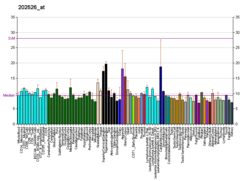SMAD4, also called SMAD family member 4, Mothers against decapentaplegic homolog 4, or DPC4 (Deleted in Pancreatic Cancer-4) is a highly conserved protein present in all metazoans. It belongs to the SMAD family of transcription factor proteins, which act as mediators of TGF-β signal transduction. The TGFβ family of cytokines regulates critical processes during the lifecycle of metazoans, with important roles during embryo development, tissue homeostasis, regeneration, and immune regulation.[5]
SMAD 4 belongs to the co-SMAD group (common mediator SMAD), the second class of the SMAD family. SMAD4 is the only known co-SMAD in most metazoans. It also belongs to the Darwin family of proteins that modulate members of the TGFβ protein superfamily, a family of proteins that all play a role in the regulation of cellular responses. Mammalian SMAD4 is a homolog of the Drosophila protein "Mothers against decapentaplegic" named Medea.[6]
SMAD4 interacts with R-Smads, such as SMAD2, SMAD3, SMAD1, SMAD5 and SMAD8 (also called SMAD9) to form heterotrimeric complexes. Transcriptional coregulators, such as WWTR1 (TAZ) interact with SMADs to promote their function. Once in the nucleus, the complex of SMAD4 and two R-SMADS binds to DNA and regulates the expression of different genes depending on the cellular context.[6] Intracellular reactions involving SMAD4 are triggered by the binding, on the surface of the cells, of growth factors from the TGFβ family. The sequence of intracellular reactions involving SMADS is called the SMAD pathway or the transforming growth factor beta (TGF-β) pathway since the sequence starts with the recognition of TGF-β by cells.
- ^ a b c GRCh38: Ensembl release 89: ENSG00000141646 – Ensembl, May 2017
- ^ a b c GRCm38: Ensembl release 89: ENSMUSG00000024515 – Ensembl, May 2017
- ^ "Human PubMed Reference:". National Center for Biotechnology Information, U.S. National Library of Medicine.
- ^ "Mouse PubMed Reference:". National Center for Biotechnology Information, U.S. National Library of Medicine.
- ^ Massagué J (October 2012). "TGFβ signalling in context". Nature Reviews. Molecular Cell Biology. 13 (10): 616–630. doi:10.1038/nrm3434. PMC 4027049. PMID 22992590.
- ^ a b Massagué J (1998). "TGF-beta signal transduction". Annual Review of Biochemistry. 67 (1): 753–791. doi:10.1146/annurev.biochem.67.1.753. PMID 9759503.






